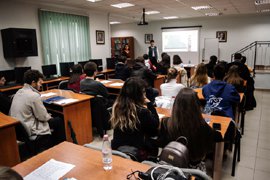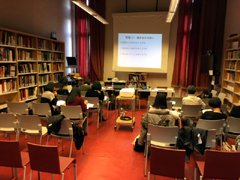Helping to Connect the Dots
The Japan Cultural Institute in Rome
TSURUTA Yasuyuki
Advisory Functions
Unlike other locations in Western Europe, the Japan Cultural Institute in Rome (hereinafter “Institute”) does not have a Japanese-Language Senior Specialist dispatched to handle advisory functions. For that reason, the Japanese-Language Specialist (hereinafter “Specialist”) dispatched here, myself, must handle both the operation of the Japanese-language course and advisory functions. These advisory duties include holding training sessions for Japanese teachers in the dispatched country and surrounding countries, forming teacher networks, and providing advice and instruction in Japanese-language teaching methods and the creation of teaching materials. During AY2018, I carried out teacher training sessions, mini lessons in Japanese for learners, and surveys on the local state of Japanese-language education in five locations in Italy (Turin, Naples Florence, Venice, and Lombardy) as well as in the surrounding countries, Albania and Greece.

A Japanese mini-lesson in Albania

A training session for Japanese language teachers
There are few opportunities for teachers to gather on a regular basis in groups that extend beyond specific regions or educational institutions within Italy and the surrounding countries. Therefore, the teacher training sessions serve as highly valuable opportunities for the teachers to meet others during the group work and discussions, to converse with each other around the lunch table, to rethink how they practice their job, to build new teacher networks, and to share their daily concerns.
I feel that one of the greatest contributions that the Specialist dispatched here by the Japan Foundation can make is to provide these types of opportunities for the teachers, normally practicing in isolation in their regions or institutions, and the students who seldom have a chance to study outside their regular classrooms.
The Survey on Japanese-Language Education Abroad 2018
AY2018 was the most recent year for the Survey on Japanese-Language Education Abroad (hereinafter “Survey”) that the Japan Foundation carries out globally to get a precise picture of the state of Japanese-language education throughout the world. This Institute was responsible for implementing the Survey in the Vatican City, the Republic of San Marino, and the Republic of Malta in the Mediterranean Sea in addition to Italy. Here I will use Italy as an example to give a brief explanation of how the Survey is carried out.
For this Survey year, we began the Survey in June. First, we sent the questionnaire and a request to participate in the Survey to any institution that had participated in past Surveys. Meanwhile, we searched for educational institutions that had begun new Japanese-language education programs since the last Survey by interviewing people in the field and searching online. Unfortunately, that research quickly stalled because most such institutions enter the summer holiday from July through September and became unreachable. And not only did the research stop during that time, but many of the institutions we had sent requests to forget about them during that holiday. As a result, we had to restart the Survey by sending the requests again in the fall. However, there were still challenges. For example, there was no shortage of institutions that had not fixed which students would be taking Japanese yet, or whether they would even hold the Japanese course this year because the new school year had only just begun, so we did not receive a good response right away. So as we waited for the right timing and sent out reminders to the institutions, fall became winter, and Christmas grew closer. We began to get a bit concerned at that point, because Christmas is the most important holiday of the year for Italians, and the hearts of the people and the face of the towns become uniformly colored by the mood of Christmas. Once that happens, our Survey will obviously become a rather low priority for them. Therefore, in an attempt to obtain a response before Christmas, we started calling the institutions directly, each of us taking on a portion of the task, to try and reach the people in charge of Japanese-language education for each institution directly. Unfortunately, actually reaching those people became another challenge in itself. Japanese is typically held as an extra-curricular course, particularly in Italian secondary educational institutions, so often the person who answered the phone at the given institution did not even know of the existence of a Japanese course, nor who the teacher was, and would try to turn us away from the start. And even when we did reach the person in charge, several of the institutions replied that they were not even sure if there would be a Japanese class this year, and that we should call back after New Year. As a result, the Survey extended into the new year, and we were finally able to complete it at the end of January.
The only data available in Italy on Japanese-language education is at the levels of primary through higher education, and outside those schools, or in other words, the only data that gives an overview of Japanese-language education in the country, is this very Survey. Accordingly, we understand that it is our mission to do our best to obtain information that is as accurate as possible to benefit those throughout the world who need that information. The results of the Survey will be made available on the Japan Foundation website during the 2019 academic year. I would be pleased if the information were to be of use to as many people as possible.
- What We Do Top
- Arts and Cultural Exchange [Culture]
- Japanese-Language Education Overseas [Language]
- Japanese-Language Education Overseas [Language] Top
- Learn Japanese-language
- Teach Japanese-language
- Take Japanese-Language Test
- Know about Japanese-language education abroad
- The Japanese-Language Institute, Urawa
- The Japanese-Language Institute, Kansai
- Japanese-Language Programs for Foreign Specified Skilled Worker Candidates
- Japanese Language Education for Japanese Children Resident Overseas and for the Descendants of Migrants
- Archives
- Japanese Studies and Global Partnerships [Dialogue]
- JF digital collection
- Other Programs / Programs to Commemorate Exchange Year
- Awards and Prizes
- Publications
